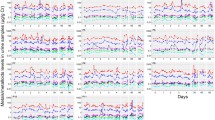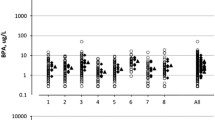Summary
The use of urinary monitoring in medical surveillance programs in industry requires the development of an accurate and unbiased index of urinary concentrations of occupational toxins. To examine the effects of urinary flow rate on adjusted and non-adjusted urinary excretion of 11 heavy metals and organic substances, 19 metal-foundry workers were studied during four time periods of the day under conditions of water restriction and loading. The results indicate that urinary flow rate significantly affects not only the non-adjusted urinary concentration for all substances, but also affects timed excretion as well as concentrations adjusted to urinary specific gravity and to urinary creatinine during any time period of the day. On the other hand, the concentration adjusted to urinary flow rate (UF-adjusted concentration) is independent by definition of urinary flow; therefore, this adjustment is applicable for highly diluted and highly concentrated urine samples without repetition of urine collection. It is concluded that UF-adjusted concentration is a useful index for the measurement of most urinary substances, while adjustments to urinary specific gravity and to urinary creatinine concentration have only limited utility in evaluating toxin levels in spot urine samples.
Similar content being viewed by others
References
Allessio L, Berlin A, Dell'Orto A, Toffoletto F, Ghezzi I (1985) Reliability of urinary creatinine as a parameter used to adjust values of urinary biological indicators. Int Arch Occup Environ Health 55:99–106
Araki S (1978) The effects of water restriction and water loading on urinary excretion of lead, delta- aminolevulinic acid and coproporphyrin. Br J Ind Med 35:312–317
Araki S (1980) Effects of urinary volume on urinary concentrations of lead, delta-aminolaevulinic acid, coproporphyrin, creatinine and total solutes. Br J Ind Med 37:50–54
Araki S, Aono H, Murata K (1986) Adjustment of urinary concentration to urinary volume in relation to erythrocyte and plasma concentrations: an evaluation of urinary heavy metals and organic substances. Arch Environ Health 41:171–177
Araki S, Murata K, Aono H, Yanagihara S, Niinuma Y, Yamamoto R, Ishihara N (1986) Comparison of the effects of urinary flow on adjusted and non-adjusted excretion of heavy metals and organic substances in ‘healthy’ men. J Appl Toxicol 6:245–251
Dell'Orto A, Berlin A, Toffoletto F, Losito B, Allessio L (1987) Creatinine and specific gravity adjustment of ALA in urinary spot samples: Is there any need? Am Ind Hyg Assoc J 48:A331-A332
Elkins HB, Pagnotto LD (1965) Is the 24-hour urine samples a fallacy? Am Ind Hyg Assoc J 26:456–460
Elkins HB, Pagnotto LD, Smith HL (1974) Concentration adjustments in urinalysis. Am Ind Hyg Assoc J 35:559–565
Evrin PE, Wibell L (1972) The serum levels and urinary excretion of β2-microglobulin in apparently healthy subject. Scand J Clin Lab Invest 29:69–74
Greenberg GN, Levine RJ (1989) Urinary creatinine excretion is not stable: a new method for assessing urinary toxic substance concentrations. J Occup Med 31:832–838
Levine L, Fahy JP (1945) Evaluation of urinary lead determinations. I. The significance of the specific gravity. J Ind Hyg Toxicol 27:217–223
Magos L (1971) Selective atomic-absorption determination of inorganic mercury and methylmercury in undigested biological samples. Analyst 96:847–853
Magos L, Clarkson TW (1972) Atomic absorption determination of total, inorganic and organic mercury in blood. JAOAC 55:966–971
Ogata M, Taguchi T (1988) Simultaneous determination of urinary creatinine and metabolites of toluene, xylene, styrene, ethylbenzen and phenol by automated high performance liquid chromatography. Int Arch Occup Environ Health 61:131–140
Ogata M, Tomokumi K, Takatsuka Y (1969) Quantitative determination in urine of hippuric acid and m- or p-methyl hippuric acid, metabolites of toluene and m- or p-xylene. Br J Ind Med 26:330–334
Soulsby J, Smith RL (1974) A simplified method for the quantitative determination of urinary coproporphyrin in lead workers. Br J Ind Med 31:72–74
Subramanian KS, Meranger JC, MacKeen JE (1983) Graphite furnace atomic absorption spectrometry with matrix modification for determintion of cadmium and lead in human urine. Anal Chem 55:1064–1067
Tomokuni K, Ogata M (1972) Simple method for determination of urinary delta-aminolevulinic acid as an index of lead exposure. Clin Chem 18:1534–1536
Watanabe H, Araki S, Sakata M, Yanagihara S, Ushio K (1972) 24-hour urinary hippuric acid excretion in “healthy” people, thinner workers and thinner addicts. J Jpn Accident Med Assoc (in Japanese) 20:577–579
Author information
Authors and Affiliations
Rights and permissions
About this article
Cite this article
Araki, S., Sata, F. & Murata, K. Adjustment for urinary flow rate: an improved approach to biological monitoring. Int. Arch Occup Environ Heath 62, 471–477 (1990). https://doi.org/10.1007/BF00379066
Received:
Accepted:
Issue Date:
DOI: https://doi.org/10.1007/BF00379066




